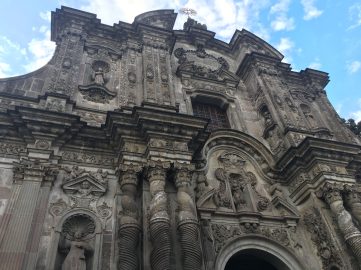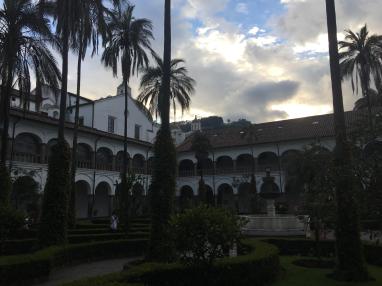The narrow gaps between buildings that passed as streets reminded me of Ireland. The outside of the church was unassuming, the white and light blue did not draw attention to the quiet sanctuary. It was only after passing through the black gate and heavy wooden doors that we began to see hints of the splendor within.
The dim inner hallway was lit by the the occasional statue of Mary or another saint. Following our guides, we skirted a peaceful garden in the center of the building and into one of the inner rooms. It opened up to high ceilings that all seemed to be bending inward to form a perfect frame around the altar and its golden backdrop. The worn wood creaked as we filed into the pews, some of the few guests allowed to experience such old tranquility.

El Carmen Bajo was only the second stop on our tour that evening and the first within the historic city center itself. Before entering the city center proper, we looked out at the sweeping cityscape from the hill that served as the yard of the Itchimbia, a “glass castle” that would be a venue space fit for any royalty. The sun weaved in and out of the clouds, providing spotlights that highlighted different parts of the city.
From El Carmen Bajo we walked through the cobbled streets and across La Plaza Grande. Its borders were formed by the Archbishop’s house, boutique shops, five-star hotels, and what could be considered Ecuador’s version of the White House. However, it was the center of the square that held one of the most interesting sights. My eyes first caught Justice, her arm stretched high into the sky, then followed down the column to the base where a tattered Spanish flag laid beside a lion pierced by an arrow. A powerful symbol of Ecuadorian independence.

Leaving La Plaza Grande behind, we continued our trek to Iglesia La Compañía de Jesús. Even the impressive carvings that decorated the exterior facade could not prepare me for the gilding inside. It seemed like everything was covered in gold leaf, in fact, we were told that half-a-ton of gold was used throughout the church. We made our way around the massive main space, making pit-stops along the way to learn about certain paintings, statues, catacombs, and artifacts.
One side of the church shines brighter than the other due to restoration efforts after a fire. This fire is also the cause of a mystery. Some of the angelic faces mounted to the ceiling had been blackened by the flames and had to be repaired. They were restored; however, a short time later, one face had once again faded to black. Caretakers again had the face repainted, and once again, it blackened. To this day, visitors will see one charred face among those in the rotunda near the altar.

Iglesia y Convento San Francisco was much like El Carmen Bajo in that after walking through the iron gate and heavy stone entrance, the area opened up into a beautiful courtyard that became the perfect frame for the setting sun. We admired the view and the nearby birds until our guide called us over to a model of the church. He used it to tell the story of how the architect of Iglesia y Convento San Francisco was struggling to finish the church on time, so he prayed for help, but received no answer. Getting desperate, he turned to the Devil and struck a deal: the demon would make sure every stone was in place by the deadline and in return, the architect would exchange his soul. As the church came closer and closer to completion, the architect started to realize what he had traded, so he again prayed for help. This time, an angel did help him by making sure the last stone was never placed, thus allowing the architect to keep his soul.
Heading down another long hallway filled with paintings, statues, and relics, we learned more about the Spanish conquest of the Incas and how religion was used to further that purpose. One of the pieces that fascinated me the most was a handmade book of songs all written in Latin. Its age, beauty, and incredible craftsmanship reminded me of the Book of Kells. The best stop, however, was up to the bell tower and roof just as dusk was settling across the city. Another once-in-a-lifetime opportunity, I could not decide whether to look out at the view or the awed expression on the faces of every member of the group.

Returning back to the courtyard, there was one last surprise at Iglesia y Convento San Francisco as our Ecuadorian hosts had arranged for some of the Native people to perform two of their traditional dances. As I watched their grace and precision, I wondered where the dances had come from, where they had started. Were they old traditions? What people would do for a fun Friday night back in the day? What did it mean to them now? I tried to read it in the performers’ faces, but could not see past their masks of concentration and showmanship.
For the last stop on our tour of Historic Quito, I found myself in the most elegant restaurant I have ever been in, Casa Gangotena. The marble floors and regal columns were bright against the darkness outside. Following the spiral staircase, we wound our way up to the outside patio where the lights of the city gleamed like stars pulled down to Earth. A perfect ending to the afternoon, the food and drinks were as spectacular as the sights.
Pro Tip: In Ecuador, guinea pig is considered a traditional delicacy and, when prepared well, is quite delicious!

One thought on “Quito’s Historic City Center”